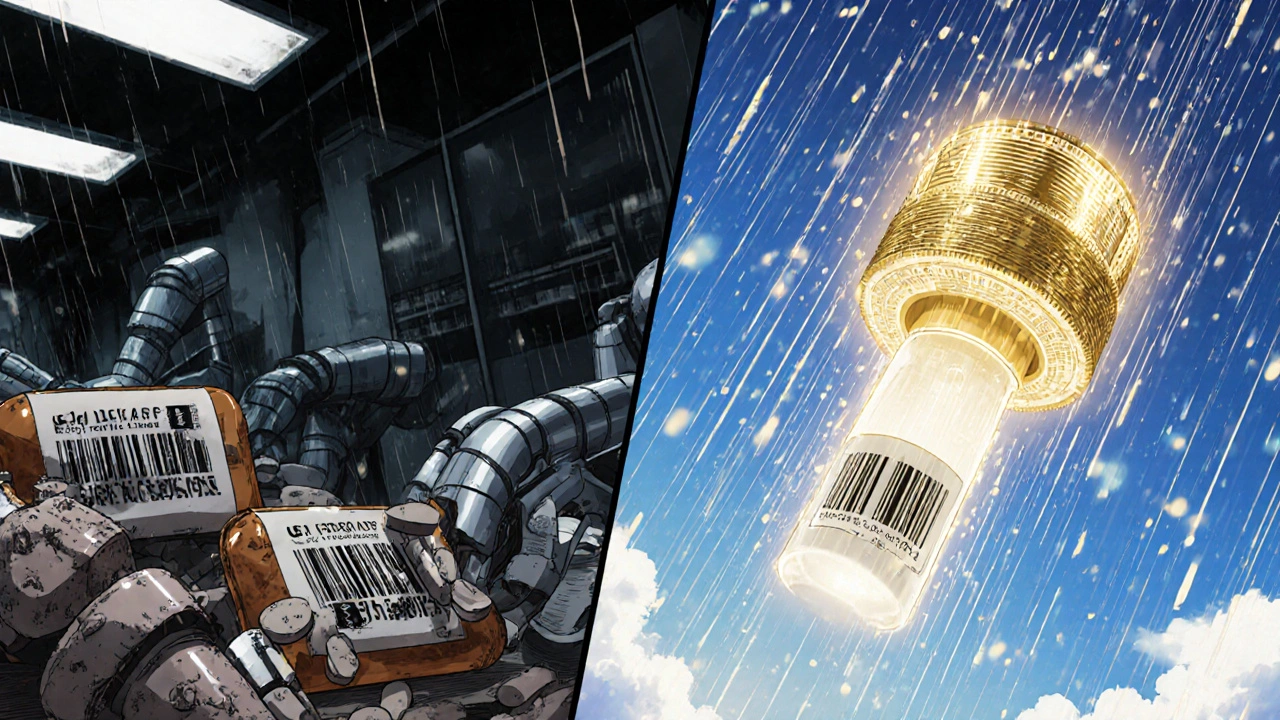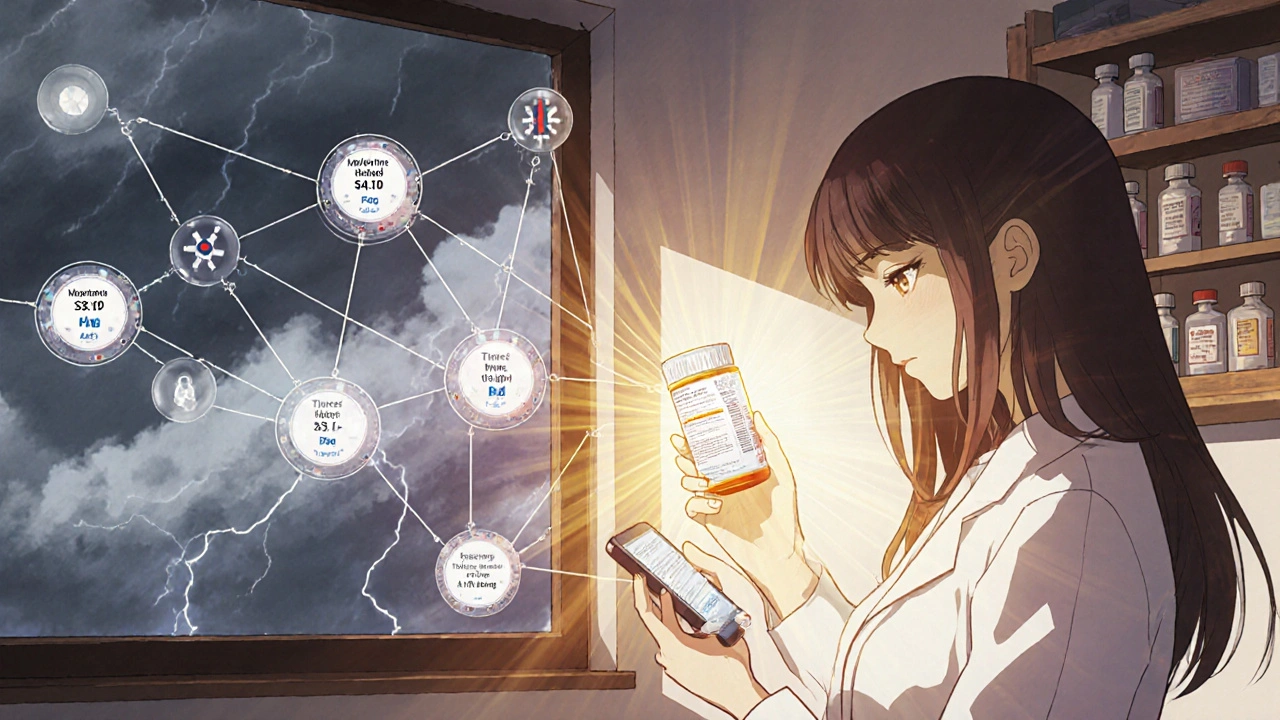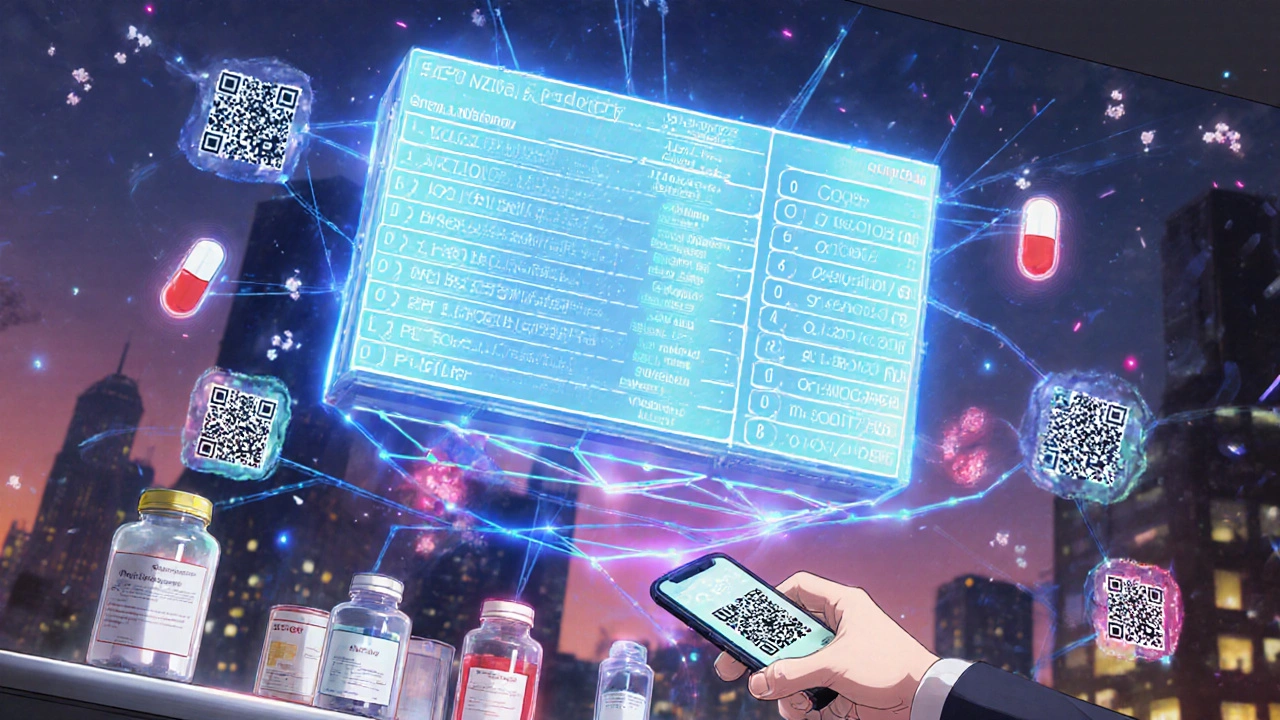Every year, millions of people around the world take generic medications believing they’re safe, effective, and identical to the brand-name version. But what if that pill you just bought online wasn’t made by the company listed on the box? What if it was filled with chalk, rat poison, or expired active ingredients? This isn’t science fiction-it’s a daily reality in parts of the global supply chain. In 2023, the World Health Organization estimated that 1 in 10 medical products in low- and middle-income countries are counterfeit. Even in the U.S., where regulations are stricter, the problem persists-especially with online pharmacies and cross-border shipments. Enter blockchain: a technology once known mostly for Bitcoin, now quietly becoming the most reliable shield against fake drugs.
How Blockchain Stops Fake Drugs Before They Reach You
Blockchain doesn’t just track drugs-it locks every step of their journey into an unchangeable digital record. Imagine each pill bottle gets its own unique digital fingerprint, like a serial number tied to a blockchain ledger. That fingerprint moves with the product from manufacturer to warehouse, to distributor, to pharmacy, and finally to you. At each point, the system checks: Is this the real item? Has it been tampered with? Was it stored properly? If anything looks off, the system flags it instantly. This isn’t guesswork. The FDA’s 2022 pilot project, involving Pfizer, Genentech, and AmerisourceBergen, showed blockchain systems could verify a drug’s authenticity in under 2.3 seconds with 99.8% accuracy. Compare that to old-school methods like holograms or color-shifting labels, which counterfeiters copy with 38% success rates. Blockchain? That number drops to 0.2%. Why? Because you can’t fake a digital signature that’s verified across hundreds of independent computers, all synchronized in real time.The Real-World Impact: Saving Lives and Money
The numbers tell a clear story. In India, Apollo Hospitals rolled out blockchain verification across 5,000 pharmacies and slashed counterfeit antimalarial drugs by 94% in just one year. In the U.S., hospitals and pharmacies saved $183 million annually in labor costs because staff no longer had to manually cross-check paper records or call distributors to confirm batch numbers. More importantly, they freed up $20 billion in safety stock-medicines kept on hand just in case something went wrong. With blockchain, you don’t need to overstock. You can trust the system. But it’s not just about money. It’s about trust. When a pharmacist scans a QR code on a generic blood pressure pill and sees a verified chain of custody stretching back to the manufacturer in Ohio, they can confidently hand it to a patient. No more second-guessing. No more panic when a batch gets recalled. The system tells them exactly where it’s been-and whether it’s safe.How It Works: From Factory to Pharmacy
Here’s the step-by-step reality-not theory:- A pharmaceutical company prints a unique GS1-compliant serial number on each package, embedded in a 2D barcode.
- That number is registered on a permissioned blockchain (usually Hyperledger Fabric or Ethereum Enterprise), not a public one like Bitcoin.
- Every time the drug changes hands-warehouse, truck, distributor, pharmacy-the new holder scans the code and updates the ledger.
- If someone tries to enter a fake serial number, the system rejects it immediately. No exceptions.
- At the pharmacy counter, a pharmacist scans the code using a mobile app. In less than three seconds, they see the full history: manufacturer, batch, shipping route, storage temps, and last verified location.

Why Generic Drugs Are the Biggest Target
Counterfeiters don’t go after expensive cancer drugs first. They go for the ones people buy in bulk: generic antibiotics, blood pressure pills, diabetes meds. Why? Because they’re cheap, widely used, and often ordered online without a prescription. A fake bottle of metformin costs $0.10 to produce and sells for $3. The profit margin is insane. Blockchain flips that script. Even if a fake bottle looks perfect, the digital fingerprint won’t match. No blockchain record? It’s blocked from sale. That’s why companies like MediLedger (now part of EY’s OpsChain) and Alibaba’s Ali Health are racing to onboard generic manufacturers. But here’s the catch: the tech is expensive. Installing DSCSA-compliant serialization equipment costs about $150,000 per production line. For a small generic maker, that’s a huge hurdle. That’s why only 31% of generic manufacturers have adopted blockchain so far-compared to 89% of top 50 branded drug companies.Limitations: Blockchain Isn’t Magic
Let’s be clear: blockchain doesn’t detect fake ingredients. It doesn’t tell you if a pill has the right dose of active drug. It only tells you if the package and its digital record match. That’s why experts like Dr. Sarah Wynn-Williams from the London School of Economics warn: “Blockchain creates a false sense of security if not combined with physical testing.” That’s why leading systems now integrate with AI-powered image analysis and spectroscopy tools. If a pill looks wrong under a microscope, the system flags it-even if the barcode is real. Some pilots, like Pfizer’s Q2 2024 test, now link blockchain with IoT sensors that track temperature and humidity during shipping. If a shipment of insulin was exposed to heat, the system knows-and blocks it before it reaches a patient. Another problem? Connectivity. Rural pharmacies in Montana or rural Kentucky sometimes have spotty internet. If the blockchain node can’t reach the ledger, verification fails. That’s why most systems now store a local cache and sync later. But it’s still a pain point. A 2024 survey by the National Community Pharmacists Association found 63% of pharmacists reported delays due to network issues.
What’s Next: The Road to 2027
The FDA just released new Blockchain Verification Standardization Guidelines in May 2024, setting mandatory protocols for all systems by January 2026. That means every pharmacy in the U.S. will soon be using the same rules, same tech, same app. No more patchwork systems. No more incompatible platforms. MediLedger’s Version 4.2, released in March 2024, already cuts false positives by 37% using AI-driven anomaly detection. Quantum-resistant cryptography is coming in 2025-2026 to guard against future hacking threats. And by 2027, McKinsey predicts 75% of prescription drugs in developed markets will be verified via blockchain. The goal isn’t perfection. It’s progress. The goal is to make it so hard and so expensive to fake a drug that it’s simply not worth the risk.What Pharmacists Are Saying
Maria Chen, a pharmacist in Ohio, started using MediLedger in early 2023. “Before, verifying a batch of 500 generic pills took 15 minutes. Now it’s 45 seconds. We’ve cut down on manual errors, and patients ask fewer questions about safety.” But she also says the training was brutal. “It took eight weeks just to get the team comfortable. The software doesn’t lie, but it doesn’t explain itself either.” That’s the real challenge-not the tech, but the people. Adoption isn’t about installing a server. It’s about changing how a whole industry thinks about trust.Should You Trust Online Pharmacies Now?
If a pharmacy uses blockchain verification and shows you the scan results? Yes, you can trust it. If they don’t offer verification? Walk away. The FDA and DEA now list only pharmacies with DSCSA-compliant systems as “verified.” Look for the seal. Ask for proof. You have the right to know your medicine is real. This isn’t just about technology. It’s about power. For decades, the drug supply chain was opaque. Manufacturers, distributors, and pharmacies operated in silos. Now, blockchain forces transparency. And when you can see every link in the chain, it’s a lot harder to hide a fake. The future of generic medicine isn’t cheaper pills. It’s verifiable pills. And that future is already here.How does blockchain prevent counterfeit drugs from entering the supply chain?
Blockchain assigns each drug package a unique digital identifier tied to a tamper-proof ledger. Every time the product changes hands-manufacturer, warehouse, distributor, pharmacy-the transaction is recorded and verified by multiple parties. If a fake product enters the chain, its digital fingerprint won’t match the blockchain record, and the system blocks it instantly. This eliminates the ability to introduce counterfeit drugs without detection.
Is blockchain only used by big pharmaceutical companies?
No, but adoption is uneven. Of the top 50 pharmaceutical companies, 89% have blockchain initiatives. However, only 31% of generic drug manufacturers have implemented it, mainly due to high setup costs-around $2.1 million per mid-sized company. Smaller firms struggle with the investment, even though the long-term savings in recalls, labor, and inventory are significant.
Can blockchain detect if a drug has the wrong ingredients?
No, blockchain only verifies the identity and journey of the packaging and documentation. It doesn’t test the chemical composition. That’s why leading systems now combine blockchain with AI-powered image analysis and spectroscopy tools to detect fake or diluted active ingredients. Blockchain ensures the right product is in the right place; physical testing ensures it’s the right substance.
What’s the difference between blockchain and traditional serialization?
Traditional serialization assigns a unique number to each package but stores the data in a single, centralized database. That creates a single point of failure-hackers or errors can corrupt the whole system. Blockchain distributes the data across multiple independent nodes, making it nearly impossible to alter or delete records. It also enables real-time verification across different companies without needing shared databases.
Are blockchain verification systems available to individual consumers?
Not directly yet. As of 2025, verification is primarily used by pharmacies and distributors. However, some pilot programs are testing consumer-facing apps that let patients scan QR codes on their medication to see its full history. These apps are expected to roll out widely by 2027, giving patients direct access to verification data for the first time.
Why is DSCSA compliance important for blockchain in drug verification?
The Drug Supply Chain Security Act (DSCSA) mandates that all prescription drugs in the U.S. be traceable at the package level by November 2023. Blockchain is the only technology that meets DSCSA’s requirements for interoperability, data integrity, and real-time verification across multiple stakeholders. Without DSCSA compliance, blockchain systems wouldn’t be legally recognized or widely adopted in the U.S. market.


8 Comments
November 21, 2025 Pramod Kumar
Man, I’ve seen this play out in rural India-kids getting fake antibiotics because the local shop had no way to verify. Blockchain ain’t magic, but it’s the first real shield we’ve had. When Apollo Hospitals rolled it out, my cousin’s hospital went from losing 3 patients a month to zero. Not because the pills got better-but because we finally knew which ones were real. That’s worth more than any profit margin.
November 22, 2025 Brandy Walley
blockchain for drugs lol so now my blood pressure pill has a crypto wallet? smh. they just want to make everything more expensive and complicated. i got my generics from mexico for $5 and they work fine. stop overengineering everything
November 24, 2025 shreyas yashas
Yeah but here’s the thing-most small generic makers in India can’t afford the $150k per line upgrade. So who gets left out? The ones who need it most. Blockchain’s great, but if it only helps the big players, we’re just building a richer wall between the haves and have-nots. Maybe open-source blockchain nodes? Or gov subsidies? Tech shouldn’t become a luxury for safety.
November 25, 2025 Suresh Ramaiyan
It’s funny how we treat tech like it’s the solution, when really it’s just a tool. The real problem isn’t counterfeit pills-it’s the erosion of trust in systems. Blockchain gives us a ledger, but trust? That’s built by transparency, consistency, and accountability over time. If a pharmacist still feels anxious scanning a code because they’ve been burned before, no algorithm fixes that. The tech helps, but the healing’s human.
November 25, 2025 Katy Bell
I work in a pharmacy in Ohio. We switched to MediLedger last year. Before? We spent 3 hours a day verifying batches. Now? Under 5 minutes. I used to cry when a patient asked if their medicine was safe. Now I hand them the phone and say, ‘Scan it. See for yourself.’ That’s not just efficiency-that’s dignity. For them. For us.
November 26, 2025 Ragini Sharma
so u mean if i buy a pill online and it has a barcode but my phone says ‘verified’… it’s still possible it’s just sugar? like… what if the barcode is real but the pill inside is chalk? 😭 i feel like i need a lab in my pocket now
November 27, 2025 Linda Rosie
Blockchain ensures provenance, not potency. This is a critical distinction. Without concurrent analytical verification, the system provides assurance of origin, not safety. Regulatory frameworks must mandate dual-layer validation: digital integrity plus chemical authenticity.
November 27, 2025 Vivian C Martinez
Just wanted to say-this is one of those rare tech stories where the impact is actually life-changing. Not just ‘convenient’ or ‘cool.’ Real, tangible, daily safety for people who can’t afford to be wrong. The cost is high, sure. But the cost of doing nothing? That’s measured in lives. We owe it to every patient to push through the friction.
Write a comment